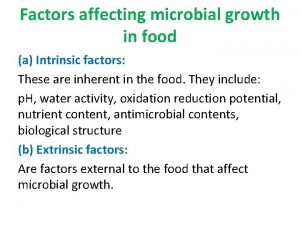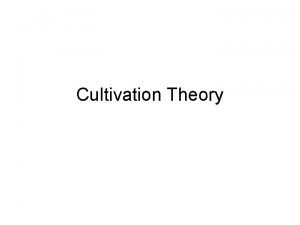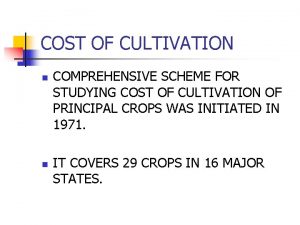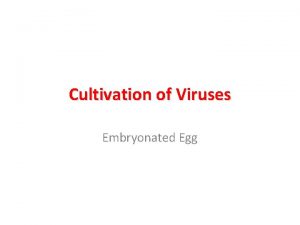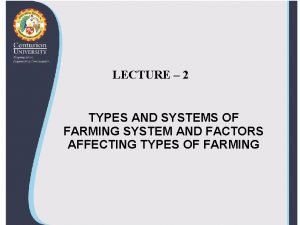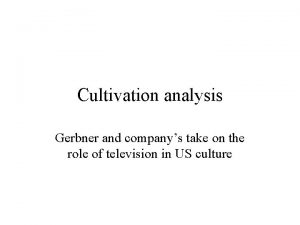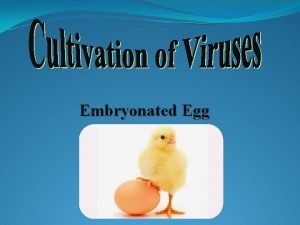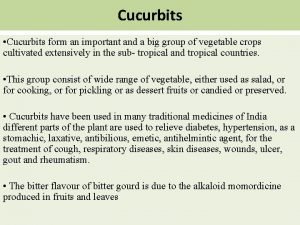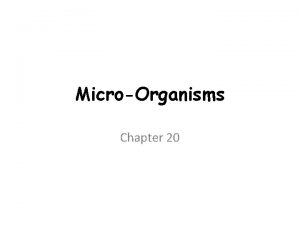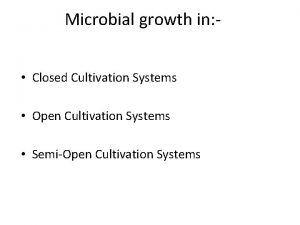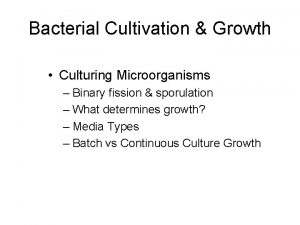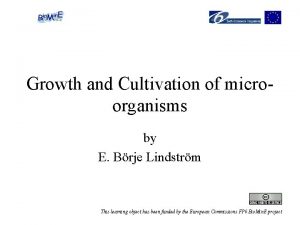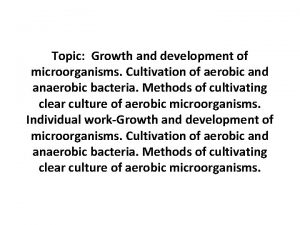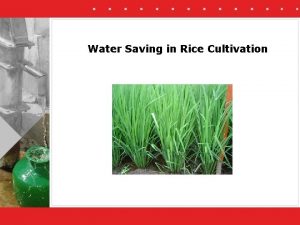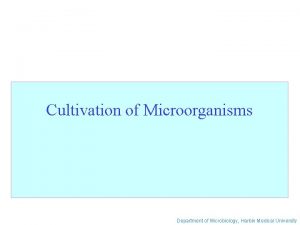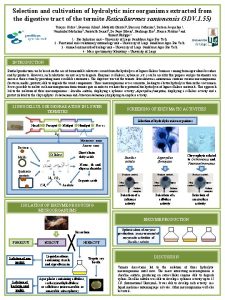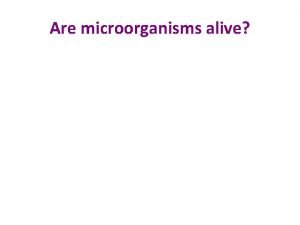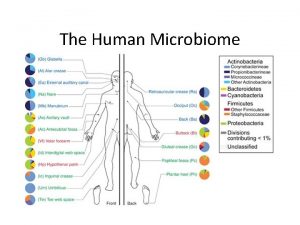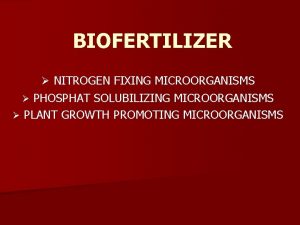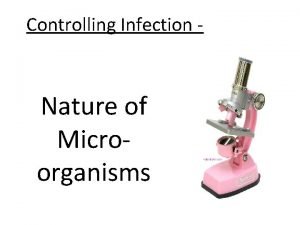CULTIVATION GROWTH OF MICROORGANISMS CULTIVATION OF MICROORGANISMS To
































- Slides: 32

CULTIVATION & GROWTH OF MICROORGANISMS

CULTIVATION OF MICROORGANISMS To determine the precise nutritional requirements of a microorganism, chemically defined media are used, because the exact composition of such media is known. Culture medium: A nutritive substance, such as an agar gel or liquid medium, in which cultures of bacteria, fungi, animal cells, or plant cells are grown. Two major types of growth media. 1. cell culture 2. microbiological culture


TYPES OF MEDIA 1. Nutrient Media 2. Minimal Media 3. Differential Media 4. Selective Media 5. Selective+Diffrential Media 6. Enrichment Media 7. Transport Media

1. Nutrient Media Nutrient media contain all the elements that most bacteria, fungi, protozoan and algae need for growth and are non-selective, so they are used for the general cultivation and maintenance of microorganisms kept in laboratory culture collections. ü An undefined medium (also a basal or complex medium). known as ü A defined medium (also known as chemically defined medium or synthetic medium).

MEDIA FOR THE GROWTH OF BACTERIA Media chosen to cultivate specific bacteria normally imitate the normal habitat of those bacteria. Autotrophic (Photo/ Chemo) Heterotrophic (Photo/ Chemo)

Example nutrient agar medium composition (HETEROTROPHIC) Ø Beef extract: 0. 3 g (minerals and carbohydrates) Ø Peptone: 0. 5 g (protein and nitrogen source) Ø Na. Cl: 0. 5 g (electrolyte) Ø Agar: 1. 5 g (solidifying agent) Ø Distilled water: 100 ml Ø p. H: 7


MEDIA FOR THE GROWTH OF FUNGI Like, bacteria, fungi absorb nutrients and do not ingest them. Absorption aided by enzymes. In general, media for fungal growth have a higher sugar concentration and low p. H.

Composition of fungal media Peptone Glucose Agar Water p. H

MEDIA FOR THE GROWTH OF PROTOZOA Most protozoa require a p. H range of 6 -8 for optimal growth. Protozoa are aerobic heterotrophs with complex nutritional requirements. Not easily grown in vitro. Require a variety of amino acids, vitamins, carbohydrates etc. Amoeba can grow in a simple peptone media while others require brain tissue emulsion, fetal calf serum, liver infusion etc. They ingest nutrients rather than absorption.

MEDIA FOR THE GROWTH OF ALGAE Algae use light for energy and require only CO 2, water and soluble inorganic salts for growth. Mostly are photoautotrophs. Few are heterotrophs. Media used is soil extract and specially defined media.

2. Minimal Media Minimal media are those that contain the minimum nutrients possible for a colony growth, generally without the presence of amino acids and are often used by microbiologists and geneticists to grow "wild type" microorganisms. A minimal medium contains only inorganic salts, a carbon source, and water.


3. Selective Media Selective media are used to enhance the growth of only selected microorganism or suppress the growth of other kinds of microorganisms. For example, if a microorganism is resistant to a certain antibiotic, such as ampicillin or tetracycline, then that antibiotic can be added to the medium in order to prevent other cells, which do not possess the resistance, from growing.

ü YM (yeast and mold) which has a low p. H, deterring bacterial growth. ü Mac. Conkey agar for Gram-negative bacteria. ü Mannitol salt agar (MSA) which is selective for Gram-positive bacteria and differential for mannitol.


4. Differential Media Differential media or Indicator media distinguish one microorganism type from another growing on the same media. Microbiologists use differential media when they want to differentiate among various kinds of microorganisms on an agar plate. This type of media is used for the detection of microorganisms and by molecular biologists to detect recombinant strains of

Examples eosin methylene blue (EMB), which differential for lactose fermentation. is Blood agar medium to differentiate b/w hemolytic vs nonhemolytic.


5. Selective/ Differential Media Some culture media are both selective and differential. For example: Mac. Conkey Agar. Inhibit the growth of gram positive and favors gram negative only. Lactose fermenting gram negative.

6. Enrichment Media An enrichment culture is a medium with specific and known qualities that favors the growth of a particular microorganism. The enrichment culture's environment will support the growth of a selected microorganism, while inhibiting the growth of others. Examples: High salt concentration will select for halophiles. High temperatures will select for thermophiles. Selenite broth is used to selectively isolate Salmonella species. Alkaline Peptone Water is used for the cultivation of vibrio. Both these examples are clinically relevant for clinical microbiology relating to stool samples.

7. Transport Media Transport media should fulfill the following criteria: 1. temporary storage of specimens being transported to the laboratory for cultivation. 2. maintain the viability of all organisms in the specimen without altering their concentration. 3. contain only buffers and salt. 4. lack of carbon, nitrogen, and organic growth factors so as to prevent microbial multiplication. 5. transport media used in the isolation of anaerobes must be free of molecular oxygen.

Examples Ø Thioglycolate broth for strict anaerobes. Ø Stuart transport medium - a non-nutrient soft agar gel containing a reducing agent to prevent oxidation and charcoal to neutralize Ø Certain bacterial inhibitors - for gonococci and buffered glycerol saline for enteric bacilli. Ø Venkat-Ramakrishnan(VR) cholerae. medium for V.

PURE CULTURE Often microbes exist in mixed population and need to be purified or isolated by single colony formation (colony members are all descendant of a single cell). Pure cultures are often obtained by streaking or spreading procedures using agar plates. Pure cultures are often frozen or lyophilized and saved. Contaminants: unwanted organisms in a culture. Cells can be grown in liquid or solid culture media.



MICROBIAL GROWTH Refers to growth of the microbial population and not to the growth of individual cells in the population. During microbial growth each individual cell grows and divides, thus their number increases as well.

GROWTH CURVE Bacterial growth has a Lag Phase (no increase in cell number, period for preparing a balanced growth) an Exponential Growth Phase ( period during which the rate of growth is constant, linear part of the curve) a Stationary Phase (end of growth due to some limitation or change of some factors rendering growth impossible, during which cell number stays the same) finally a Decline or Death Phase (beyond a certain period at stationary phase, cells start to die, so their viability decline).


GROWTH MEASUREMENT Usually by monitoring the mass increase either by measuring total weight of cells periodically or by monitoring the increase of a chemical as cell constituent or by directly counting the number of cells using a counting chamber or a coulter counter or monitoring indirectly the turbidity of cell cultures.

Effect of Environmental Conditions of Growth Acidophiles Alkalophiles Aerobic Anaerobic Psychrophiles Mesophiles Thermophiles
 Intrinsic factors affecting microbial growth in food
Intrinsic factors affecting microbial growth in food Bacterial growth curve
Bacterial growth curve Vascular ray
Vascular ray Shoot system
Shoot system Geometric growth vs exponential growth
Geometric growth vs exponential growth Carothers equation
Carothers equation Neoclassical growth theory vs. endogenous growth theory
Neoclassical growth theory vs. endogenous growth theory Primary growth and secondary growth in plants
Primary growth and secondary growth in plants Difference between organic and inorganic growth
Difference between organic and inorganic growth Relative growth rates
Relative growth rates Colebrook on bengal ryots
Colebrook on bengal ryots Bp blg 232
Bp blg 232 Wanderfeldbau definition
Wanderfeldbau definition Taungya cultivation most popular in
Taungya cultivation most popular in Cultivation theory definition
Cultivation theory definition Cost of cultivation scheme
Cost of cultivation scheme Egg inoculation diagram
Egg inoculation diagram Cultivation of viruses
Cultivation of viruses How many types of farming systems are there
How many types of farming systems are there Whats shifting cultivation
Whats shifting cultivation Shifting cultivation aphg
Shifting cultivation aphg Extentous
Extentous Cultivation
Cultivation Cultivation analysis
Cultivation analysis Method of cultivation of virus
Method of cultivation of virus Define cultivation theory
Define cultivation theory Polarzone klimadiagramm
Polarzone klimadiagramm Scope of protected cultivation
Scope of protected cultivation Art of cultivation
Art of cultivation George gerbner theory
George gerbner theory Intensive rice cultivation
Intensive rice cultivation Snap melon in hindi
Snap melon in hindi Vegetable forcing
Vegetable forcing
